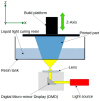4D Printing in Biomedical Engineering: Advancements, Challenges, and Future Directions
- PMID: 37504842
- PMCID: PMC10381284
- DOI: 10.3390/jfb14070347
4D Printing in Biomedical Engineering: Advancements, Challenges, and Future Directions
Abstract
4D printing has emerged as a transformative technology in the field of biomedical engineering, offering the potential for dynamic, stimuli-responsive structures with applications in tissue engineering, drug delivery, medical devices, and diagnostics. This review paper provides a comprehensive analysis of the advancements, challenges, and future directions of 4D printing in biomedical engineering. We discuss the development of smart materials, including stimuli-responsive polymers, shape-memory materials, and bio-inks, as well as the various fabrication techniques employed, such as direct-write assembly, stereolithography, and multi-material jetting. Despite the promising advances, several challenges persist, including material limitations related to biocompatibility, mechanical properties, and degradation rates; fabrication complexities arising from the integration of multiple materials, resolution and accuracy, and scalability; and regulatory and ethical considerations surrounding safety and efficacy. As we explore the future directions for 4D printing, we emphasise the need for material innovations, fabrication advancements, and emerging applications such as personalised medicine, nanomedicine, and bioelectronic devices. Interdisciplinary research and collaboration between material science, biology, engineering, regulatory agencies, and industry are essential for overcoming challenges and realising the full potential of 4D printing in the biomedical engineering landscape.
Keywords: 4D printing; biocompatibility; biomedical engineering; fabrication techniques; smart materials.
Conflict of interest statement
The authors declare no conflict of interest.
Figures










References
-
- Asif M., Lee J.H., Lin-Yip M.J., Chiang S., Levaslot A., Giffney T., Ramezani M., Aw K.C. A new photopolymer extrusion 5-axis 3D printer. Addit. Manuf. 2018;23:355–361. doi: 10.1016/j.addma.2018.08.026. - DOI
-
- Domett P., Arjmandi M., Ramezani M. Design and manufacturing of knee implants for osteoarthritis patients. Solid State Phenom. 2020;311:1–11.
-
- Marinopoulos T., Li S., Silberschmidt V.V. Structural integrity of 3D-printed prosthetic sockets: Experimental study for paediatric applications. J. Mater. Res. Technol. 2023;24:2734–2742. doi: 10.1016/j.jmrt.2023.03.192. - DOI
-
- Yang J., Yang K., Man W., Zheng J., Cao Z., Yang C.-Y., Kim K., Yang S., Hou Z., Wang G., et al. 3D bio-printed living nerve-like fibers refine the ecological niche for long-distance spinal cord injury regeneration. Bioact. Mater. 2023;25:160–175. doi: 10.1016/j.bioactmat.2023.01.023. - DOI - PMC - PubMed
Publication types
LinkOut - more resources
Full Text Sources
Research Materials

